The Egyptian Surrealist group Art et Liberté chose the image of Picasso’s Guernica (1937) to illustrate their first manifesto, Vive l’art dégénéré (Long live degenerate art), published in 1938. Fittingly, the document is now going on show at the monumental painting's home, Madrid's Museo Nacional Centro de Arte Reina Sofía, as part of the exhibition Art et Liberté: Rupture, War and Surrealism in Egypt (1938-48) (until 28 May).

Organised by the independent curators Till Fellrath and Sam Bardaouil, the show traces the history and production of the little-known Surrealist-inspired group for the first time. Art et Liberté attracted a young generation of artists, intellectuals and activists in a time of great cultural and political reform in Egypt and became part of an international movement defying fascism, nationalism and colonialism. Five years in the making, the show aims to reveal an aspect of art history that has largely been forgotten within Egypt but also hopes to add to the understanding of Surrealism as an international movement.
The first iteration of the exhibition opened at the Pompidou, Paris, in October last year in honour of the 50th anniversary of the death of Surrealism’s founder, André Breton (1896-1966). The exhibition at Museo Nacional Centro de Arte Reina Sofía will feature around 70% of the works and materials from the Pompidou, with around 200 paintings, works on paper, photographs and archival materials from the late 1920s to the early 1950s. The pieces are on loan from 42 public and private collections in ten different countries.
The exhibition will travel to The Kunstsammlung Nordrhein-Westfalen, Düsseldorf (15 July-15 October) and Tate Liverpool (17 November-18 March). It is supported by HE Sheikh Dr Hassan bin Mohammed bin Ali Al Thani and Montblanc Cultural Foundation.


